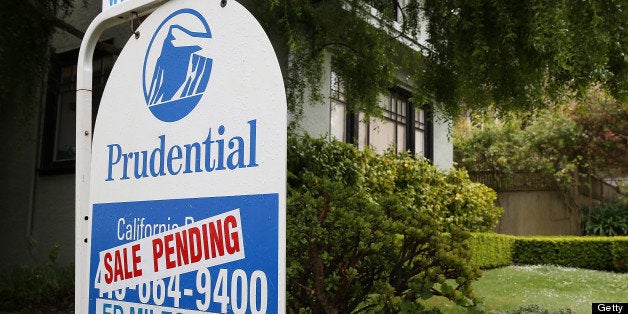For the millions of homeowners who saw the value of their properties plunge during the housing crash, a new report out Tuesday that indicates home prices are increasing at the fastest clip on record comes as welcome news.
But to some housing experts and local-level real estate professionals, the spikes are worrisome and don't reflect a truly healthy market.
"A lot of people may be making the wrong bet right now," said Scott Samuels, a realtor in St. Petersburg, Fla., whose clients include local small investors who are betting on future rapid price increases, as well as ordinary buyers.
Those who bought homes in the area years ago have benefitted hugely from climbing prices, which have soared 50 percent, Samuels said. But investment trusts and others who have recently barnstormed the Tampa Bay region may be coming in too late, riding a wave of speculation, he said.
"There's a sense that the train is leaving the station and people are running to catch it," he said.
Tuesday's Standard & Poor/Case-Shiller 20-city home price index revealed home prices were up 2.5 percent in April, the largest month-to-month increase since at least 2000, when the sales data was first collected. Year-to-year, prices leapt 12.1 percent, the biggest increase since the market's peak in 2006.
This time around, it isn't securitization-mania that is propelling the price growth, but another kind of frenzy. Over the last year, especially, Wall Street hedge funds bearing armloads of cash have joined mom-and-pop investors in many of the markets that were once hotbeds of foreclosure activity. In cities like Sacramento and Atlanta, these buyers are scooping up available properties nearly the moment they are listed for sale.
Prices in Tampa were up 11.3 percent from the previous year, according to the Case-Shiller index. In Phoenix, prices were up a whopping 21.5 percent. Overall, prices remain down about 25 percent from the 2006 peak.
Lawrence Yun, the chief economist at the National Association of Realtors, says the current rate of increase simply isn't sustainable. In the most basic calculus, home prices should roughly mirror growth in incomes, he said. Yet prices are rising at a double-digit pace, while incomes are up just 1 or 2 percent.
"The price increases are misaligning with other economic fundamentals," Yun said.
The Case-Shiller index is based on sales numbers for April, and may not fully reflect the most recent market trends. The rate on the average 30-year fixed-rate mortgage has climbed since then, and is now about 4.25 percent, up nearly a percentage point since earlier this year.
Some analysts have suggested that demand may already be starting to slow, as a result of these increased borrowing costs. David Kotok, chairman of Cumberland Advisors, recently wrote that the refinancing wave will come to a stop. He cited John Rosner, another analyst, who suggested that investor appetite will likely also wane.
For now, ordinary home buyers -- those actually looking for a place to live -- are often finding their efforts thwarted against better-financed competitors, who can often pay cash.
Would-be buyers are also competing for a smaller and smaller pool of homes: Inventory is down precipitously in many of the biggest markets. The supply of available homes in Phoenix, for example, is less than two months, according to a measure that realtors typically use to gauge inventory.
Healthy markets typically have a six- to nine-month supply.
In these big markets, hedge funds like Blackstone are buying up so many available properties that even local investors, who often buy and flip homes, say they are being crowded out.
“I don’t like the competition,” Marty Boardman, a Phoenix-area flipper recently told The Huffington Post. “I want to be in a housing market where they appreciate me and my lowball cash offers.”
Our 2024 Coverage Needs You
It's Another Trump-Biden Showdown — And We Need Your Help
The Future Of Democracy Is At Stake
Our 2024 Coverage Needs You
Your Loyalty Means The World To Us
As Americans head to the polls in 2024, the very future of our country is at stake. At HuffPost, we believe that a free press is critical to creating well-informed voters. That's why our journalism is free for everyone, even though other newsrooms retreat behind expensive paywalls.
Our journalists will continue to cover the twists and turns during this historic presidential election. With your help, we'll bring you hard-hitting investigations, well-researched analysis and timely takes you can't find elsewhere. Reporting in this current political climate is a responsibility we do not take lightly, and we thank you for your support.
Contribute as little as $2 to keep our news free for all.
Can't afford to donate? Support HuffPost by creating a free account and log in while you read.
The 2024 election is heating up, and women's rights, health care, voting rights, and the very future of democracy are all at stake. Donald Trump will face Joe Biden in the most consequential vote of our time. And HuffPost will be there, covering every twist and turn. America's future hangs in the balance. Would you consider contributing to support our journalism and keep it free for all during this critical season?
HuffPost believes news should be accessible to everyone, regardless of their ability to pay for it. We rely on readers like you to help fund our work. Any contribution you can make — even as little as $2 — goes directly toward supporting the impactful journalism that we will continue to produce this year. Thank you for being part of our story.
Can't afford to donate? Support HuffPost by creating a free account and log in while you read.
It's official: Donald Trump will face Joe Biden this fall in the presidential election. As we face the most consequential presidential election of our time, HuffPost is committed to bringing you up-to-date, accurate news about the 2024 race. While other outlets have retreated behind paywalls, you can trust our news will stay free.
But we can't do it without your help. Reader funding is one of the key ways we support our newsroom. Would you consider making a donation to help fund our news during this critical time? Your contributions are vital to supporting a free press.
Contribute as little as $2 to keep our journalism free and accessible to all.
Can't afford to donate? Support HuffPost by creating a free account and log in while you read.
As Americans head to the polls in 2024, the very future of our country is at stake. At HuffPost, we believe that a free press is critical to creating well-informed voters. That's why our journalism is free for everyone, even though other newsrooms retreat behind expensive paywalls.
Our journalists will continue to cover the twists and turns during this historic presidential election. With your help, we'll bring you hard-hitting investigations, well-researched analysis and timely takes you can't find elsewhere. Reporting in this current political climate is a responsibility we do not take lightly, and we thank you for your support.
Contribute as little as $2 to keep our news free for all.
Can't afford to donate? Support HuffPost by creating a free account and log in while you read.
Dear HuffPost Reader
Thank you for your past contribution to HuffPost. We are sincerely grateful for readers like you who help us ensure that we can keep our journalism free for everyone.
The stakes are high this year, and our 2024 coverage could use continued support. Would you consider becoming a regular HuffPost contributor?
Dear HuffPost Reader
Thank you for your past contribution to HuffPost. We are sincerely grateful for readers like you who help us ensure that we can keep our journalism free for everyone.
The stakes are high this year, and our 2024 coverage could use continued support. If circumstances have changed since you last contributed, we hope you'll consider contributing to HuffPost once more.
Already contributed? Log in to hide these messages.


